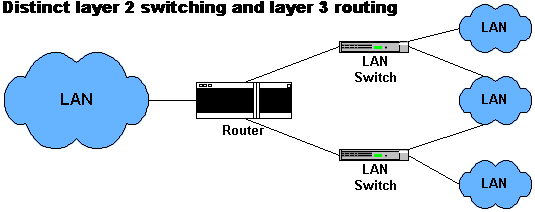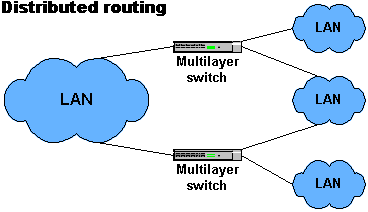![]()

A router is a device that interconnects networks and decides the best path over which to send data between networks. Routers use the logical (e.g. IP) address information contained within ethernet frames.
It is also possible to define a router as a device that "switches" at the internet layer (layer 3) of the TCP/IP protocol suite. Routers should not be confused with ethernet switches that operate using the medium access control (MAC) address, inherent in the network interface card, at the datalink sublayer (layer 2) of the network access layer.
The internet layer protocol declares the logical source and destination addresses and any routing parameters in the frame. A good example of such a parameter is the number of routers a frame is allowed to cross prior to reaching its destination. Therefore, a packet can almost be assigned a level of priority. Switches and routers can interoperate, but multilayer switches are available that provide datalink switching and internet routing in one device.
The use of routers and multilayer switches has evolved to produce two different architectures:

Distinct layer 2 switching and layer 3 routing utilises separate routers and switches. As stated above, ethernet switches operate at layer 2 and ethernet routers operate at layer 3. The LAN switches handle the interconnection needs of the small, geographically close, LANs. A single router is used to handle traffic between the larger remote LAN and the smaller LANs. This is a fairly common architecture. Some networking professionals think that networks should switch if they can and route if they must.

Distributed routing does away with separate switches and routers. Instead, multilayer switching is employed to handle network traffic between the small LANs and the remote LAN. The use of a single, relatively expensive, device does not create a significant cost reduction initially, but the reduced management needs should not be underestimated.
A router will examine a frame and determine the logical address of the destination device from the internet layer protocol header. Routers hold a routing table, listing available networks, that allows them to effectively switch network traffic over the most effective route. These tables also include a measure of the quality of the connection to a network and the address of the next device required to forward data to that network. Routers share the information held in these routing tables and they are able to incorporate new routes to networks, as they are added, and delete routes that have become unstable or unusable. A router modifies frames by altering the source MAC (layer 2) address to its own. The source and destination logical addresses remain the same.
There is a great deal of discussion over the future of routing and there are three possibilities:
| 3Com's enterprise router page | Commercial page showing 3Com's products |
| Cisco's router page | Commercial page showing Cisco's products |
| Routers - Central Institute of Technology | General router information |